Olive-backed Sunbird
Table of Contents
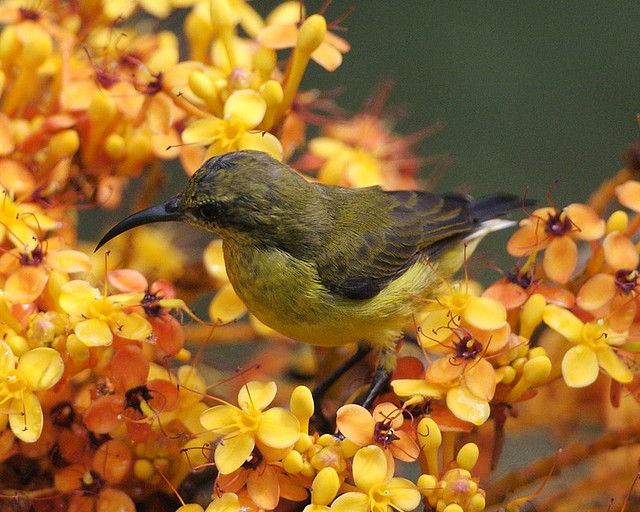 |
| A female olive-backed sunbird. Picture is under Creative Commons Attribution-Share Alike 2.0 Generic license. The photo was taken by Dr. L. K. Yap. |
Name
Species Name: Nectarinia jugularis (Linnaeus, 1766)Synonym: Cinnyris jugularis, Certhia jugularis, Cyrtostomus ornatus, Leptocoma jugularis
Common Name: Olive-backed sunbird, Yellow-breasted sunbird, Malayan Yellow-breasted sunbird, Yellow-bellied sunbird
Etymology
The word "jugularis" means "pertaining to throat or neck". It likely refers to the metallic blue-colored throat of the male bird.Diagnosis
Olive-backed sunbird has olive-colored back side, grayish-brown wings and conspicuous yellow underpart [6] . In females, other than the underpart, the yellow coloration covers the chest, throat and chin as well, while in males these parts and forehead are glossy black, iridescent with bluish-green and dark purple [7] [8] .In Singapore, the species that can superficially look similar to olive-backed sunbird is the plain-throated sunbird (Anthreptes malacensis). However, two species are rather different in size; while olive-backed sunbird is approximately 11cm in length, plain-throated sunbird is bigger, measuring approximately 14cm in length [9] . Also, the male plain-throated sunbird has brown colored throat instead of iridescent blue-black-colored throat [10] .
.
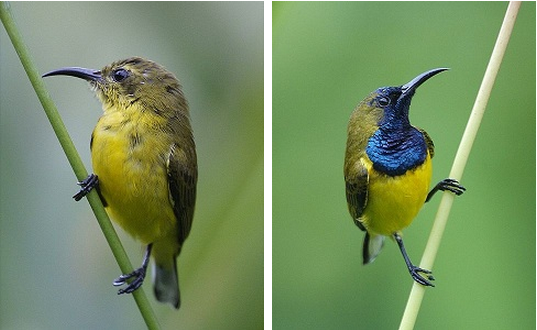 |
| Adult female (left) and adult male (right). Pictures are under Creative Commons Attribution-Share Alike 2.0 Generic license. The photos were taken by Dr. L. K. Yap. |
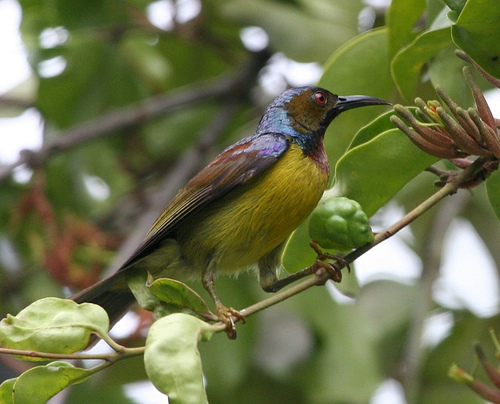 |
| Male plain-throated sunbird. Note the difference in coloration. Pictures are under Creative Commons Attribution-Share Alike 2.0 Generic license. The photo was taken by Dr. L. K. Yap. |
Description
Adult
Adults all have olive-colored back side, grayish-brown wings and yellow colored underpart [11] . The iris is of dark to very dark brown, while the bills and feet are black-colored [12] . This species shows sexual dimorphism. In females, the chest, throat, chin are yellow colored, which is the same color with underpart, while in males these parts and forehead are glossy black, iridescent with bluish-green and dark purple sheen [13] [14] . The curve on the beak of this sunbird is greater than in many other sunbird species [15] . They are capable of quick wing beat, and the flight is quick and darting [16] . Their call is a crisp "tweet tweet", Potter (1948) mentioned that the males can produce a sharp, clear "cheew-wee tweet tweet tweet tweet tweet" song, and when the birds are flying they twitter like swallows [17] .The video above shows a male olive-backed sunbird singing. Calls of the sunbird can be found in MacAulay Library too, which belongs to Cornell Lab of Ornithology. Below is the link to one of the audio clip.
Call of olive-backed sunbird
Juveniles
Upon hatching, the hatchlings have clear orange skin without melanin pigment spots until later stage [18] . The juveniles first plumage is indistinguishable from that of females, and therefore they all initially look like females [19] . However, male juveniles slowly grow the blue throat, and they may often be seen with just a few blue feathers, or a thin blue streak down the throat [20] .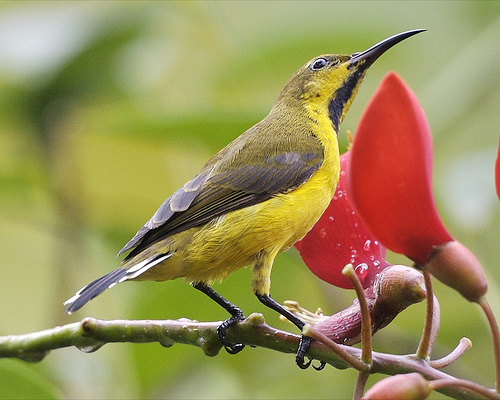 |
| A young male olive-backed sunbird. Pictures are under Creative Commons Attribution-Share Alike 2.0 Generic license. The photos were taken by Dr. L. K. Yap. |
Biology
Habitat
Olive-backed sunbird can be found in many habitat such as secondary forests, orchards and plantations, mangrove forest, open areas, urban areas and etc, except of denser forest such as primary forest [21] [22] [23] . Particularly common outside of forest, in gardens and around the coast [24] [25] . The altitude which this bird is recorded is from sea level to 600m; it frequents different strata of forest including ground, understorey, midstorey and canopy [26] [27] [28] .In presence of honeyeaters where there is competition for similar resources, olive-backed sunbird is often found outside of forest but absent in forest [29] .
Feeding Habit
Olive-backed sunbird is a generalist nectarivore [30] , it feed on flowers of Bruguiera, Callistemon, Erythrina and Russelia genus [31] [32] [33] . Study has shown that the flowers that olive-backed sunbirds visit are usually bilabiate or tubular in shape, and white, orange or red in color [34] . The birds often forage in pairs or small groups, one male and one female; they perch on the branches and turn their head upwards to obtain nectar via their bills [35] [36] . The adults feed juveniles spiders and insects such as termites, and possibly nectar [37] .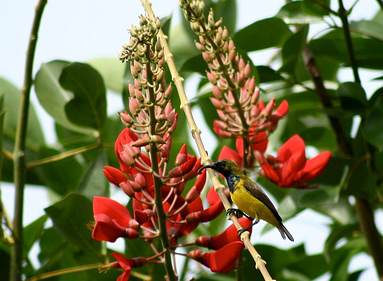 |
| A male olive-backed sunbird perching on a tree of Erythrina genus, which is one of the food plant for the sunbirds. The photo was taken by Mr. Foster Kerrison. Permission was given by photographer to use this photo. |
Reproduction
The documented breeding season for Singapore is from January to July [38] .One study recorded that during courtship, "the male began to flutter, his wings unfolded, also fluttering rapidly. At the same time it everted its orange-yellow pectoral tufts, which consists of fine feathers extending out from under its shoulders. The male also moved from side to side, attempting to approach females and making loud calls" [39] .
After copulation, females usually lay one or two eggs in one clutch [40] .
Nesting and nestling care
The nest is often made low down in bushes and trees, sometimes on verandas; sometimes the birds also build nests near human's houses such as high up in balconies, in bedrooms and etc [41] . The nest has an overhanging porch at the entrance, and the outside of the nest is made up of woven branches and plant materials, decorated with various lichens, dead leaves, seed cases, sometimes even including caterpillar fecal pellets (Figure 3) [42] . In Australia, the nests are reported that they tend to be situated towards the interior of vegetation instead of periphery, and the nest sites are typically located under canopy of trees and often suspended over water [43] [44] .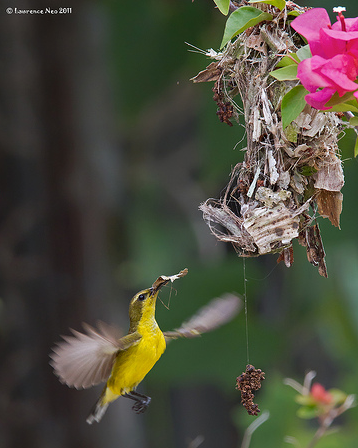 |
| A female olive-backed sunbird building a nest. The photo was taken by Mr. Lawrence Neo. Permission was given by photographer to use this photo. |
Female adults do most of the nestling feeding; the feeding is by regurgitation and the food is usually not carried in the bill [45] . The female transfer the food to the nestling with rapid pumping head movements [46] . Brooding is generally done at night to keep nestlings warm [47] .
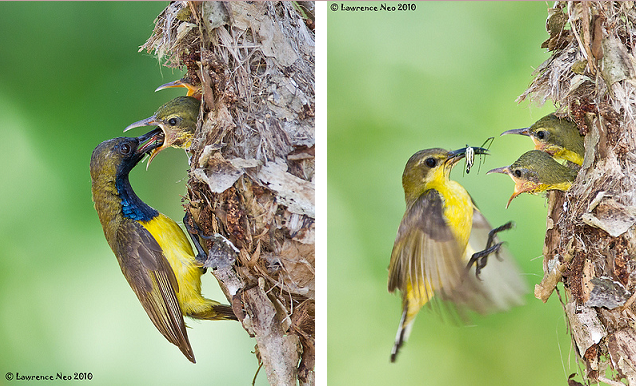 |
| Both male and female sunbirds take care of the young. The photos were taken by Mr. Lawrence Neo. Permission was given by photographer to use this photo. |
Ecological services
Olive-backed sunbird is one of the pollinator for mangrove trees such as Bruguiera species, and therefore can act as effective pollen dispersers [48] . In fact, study suggests that some species like Bruguiera exaristata is very dependent on olive-backed sunbird for pollination to the extent that the geographical distribution of the plant coincides closely with that of olive-backed sunbird [49] .Parasites
Parasites such as cestode Allohymenolepis palawanensis and has been discovered from adult olive-backed sunbird [50] . Mites Sternostoma tracheacolum has been found in nasal cavity of olive-backed sunbird [51] .Conservation status
According to IUCN Red list, Olive-backed sunbird is under "Least Concern" category [52] .Distribution
Olive-backed sunbird has very wide distribution, including Andaman and Nicobar Islands [53] , Australia [54] [55] , Borneo, Malaysia [56] [57] , Burma [58] , Guadalcanal and Tulagi Islands [59] , Indonesia [60] [61] [62] , Papua New Guinea [63] , Philippine [64] , Solomon Islands [65] , Singapore [66] , Thailand [67] and others.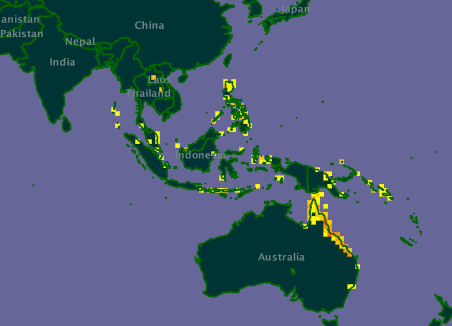 |
| Distribution of Olive-backed sunbird (Accessed through GBIF Data Portal, data.gbif.org, 2011-11-13) |
Another map made by The Internet Bird Collection, Lynx Edicion can be accessed through here:
Olive-backed sunbird distribution map
Classification
The classification of olive-backed sunbird here is according to Christidis & Boles, 2008.Kingdom: Animalia
Phylum: Chordata
Subphylum: Vertebrata
Class: Aves
Order: Passeriformes
Family: Nectariniidae
Genus: Nectarinia
Species: Nectarinia jugularis (Linnaeus, 1766)
Taxonomy
Olive-backed sunbird was first recorded on Systema Naturae under the name "Certhia jugularis", and during that time it was placed under order "Picae", which is the Piciformes [68] [69] .During early 1920s to 50s the olive-backed sunbird in Singapore has been classified under genus Leptocoma, family Nectariniidae, making it Leptocoma jugularis [70] [71] . There were some sunbirds that had been placed under genus Cyrtostomus, and apparently many species that used to be under this genus are now classified as subspecies of olive-backed sunbird [72] [73] .
Currently, olive-backed sunbird is placed under order Passeriformes, family Nectariniiidae [74] (Christidis & Boles, 2008). Irwin (1999)[75] divided the large genus Nectarinia into nine genera, in which eight of them are endemic to Africa, and this practice was followed by Fry (2000) [76] and Cheke et al. (2001) [77] . Under this classification, the Australian and Asian olive-backed sunbird would be placed under genus Cinnyris, which makes the scientific name Cinnyris jugularis. However, Christidis & Boles (2008) [78] pointed out that the mitrochondrial DNA sequence studies of Bowie (2003) [79] did not find support for classification of Irwin (1999), and therefore the species was retained as Nectarinia jugularis. In Singapore, both Nectarinia jugularis and Cinnyris jugularis are used [80] [81] . The summary of the various synonyms of olive-backed sunbird is provided below (Table 1).
| Scientific Name |
Validity |
| Certhia jugularis |
Invalid, obsolete name |
| Leptocoma jugularis |
Invalid, obsolete name |
| Cyrtostomus ornatus |
Invalid, obsolete name |
| Cinnyris jugularis |
Valid, junior synonym |
Subspecies info
There are currently 22 valid subspecies of olive-backed sunbird (Table 2) [82] .Table 2: List of subspecies of olive-backed sunbird, with protonyms and the status.
Type specimen
In this section, the scientific name used is according to how they were named in museum, therefore in several cases genus name "Cinnyris" will be used.The holotype of a species is the ultimate specimen that one can refer to and compare with, therefore it is important to know where the holotypes can be found.
Holotype of subspecies Nectarinia jugularis robustirostris and Nectarinia jugularis teysmanni can be found in National Museum of National History Naturalis, Leiden [83] .
Holotype of subspecies Cinnyris jugularis infrenatus, Cinnyris jugularis buruensis, Cinnyris jugularis keiensis, Cinnyris jugularis idenburgi, Cinnyris jugularis frenatus and lectotype of subspecies Cinnyris jugularis plateni can be found in American Museum of Natural History [84] .
In Singapore, there are 18 specimens of olive-backed sunbird in the collection of Raffles Museum of Biodiversity Research [85] .
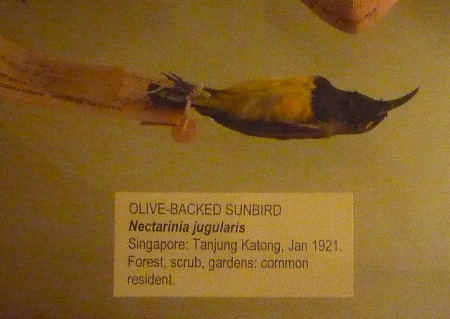 |
| One of the olive-backed sunbird specimen in Raffles Museum of Biodiversity Research, Singapore. Photo taken by Jong Ying Wei. |
Discussion area
Feel free to make any comments or ask any questions in the discussion area below.HTML Comment Box is loading comments...
Links to other pages and websites
Home pageAvibase Olive-backed Sunbird page
Internet bird collection: Olive-backed Sunbird
GBIF profile for Olive-backed sunbird
References for footnotes
- ^ Lim, K. S., 2009. The Avifauna of Singapore. Nature Society (Singapore), Singapore. 611pp.
- ^ Lim, K. S., 2009. The Avifauna of Singapore. Nature Society (Singapore), Singapore. 611pp.
- ^ Lim, K. S., 2009. The Avifauna of Singapore. Nature Society (Singapore), Singapore. 611pp.
- ^ Fain, M. G. & P. Houde, 2004. Parallel radiations in the primary clades of birds. Evolution, 58(11): 2558-2573.
- ^ Bowie, R. C. K., 2003. Birds, Molecules and Evolutionary patterns among Africa's Islands in the Sky. PhD Thesis, University of Cape Town, South Africa.
- ^ Potter, N. S., 1948. Notes on the yellow-breasted sunbird. The Wilson Bulletin, 60(3): 159-163.
- ^ Potter, N. S., 1948. Notes on the yellow-breasted sunbird. The Wilson Bulletin, 60(3): 159-163.
- ^ Hails, C., 1987. Birds of Singapore. Times Edition, Singapore. Pp 148-149.
- ^
Hails, C., 1987. Birds of Singapore. Times Edition, Singapore. Pp 148-149.
Potter, N. S., 1948. Notes on the yellow-breasted sunbird. The Wilson Bulletin, 60(3): 159-163.
Maher, W. J., 1991. Growth and development of the yellow-bellied sunbird Nectarinia jugularis in North Queensland. Emu, 91: 58-61.
Hails, C., 1987. Birds of Singapore. Times Edition, Singapore. Pp 148-149.
Diamond, J. M., 1975. Distributional ecology and habits of some bougainville birds (Solomon Islands). The Condor, 77(1): 14-23.
Clough, Y., D. D. Putra, R. Pitopang & T. Tscharntke, 2009. Local and landscape factors determine functional bird diversity in Indonesian cacao agroforestry. Biological conservation,142: 1032-1041.
Tomlinson, P. B., R. B. Primack & J. S. Bunt, 1979. Preliminary observations on floral biology in mangrove Rhizophoraceae. Biotropica, 11(4): 256-277.
Lim, K. S., 2009. The Avifauna of Singapore. Nature Society (Singapore), Singapore. 611pp.
Tsang, K. C., L. K. Wang & Y. C. Wee, 2008. The olive-backed sunbird, Cinnyris jugularis Linnaeus, 1766 and its pectoral tufts.
Maher, W. J., 1992. Breeding biology of the yellow-bellied sunbird Nectarinia jugularis in Northern Queensland. Emu, 92: 57-60.
Hails, C., 1987. Birds of Singapore. Times Edition, Singapore. Pp 148-149.
Maher, W. J., 1996. Nestling food and feeding frequencies of the brown-backed honeyeater Ramsayornis modestus and the yellow-bellied sunbird Nectarinia jugularis in northern Queensland. Emu, 96: 17-22.
Tomlinson, P. B., R. B. Primack & J. S. Bunt, 1979. Preliminary observations on floral biology in mangrove Rhizophoraceae. Biotropica, 11(4): 256-277.
Tomlinson, P. B., R. B. Primack & J. S. Bunt, 1979. Preliminary observations on floral biology in mangrove Rhizophoraceae. Biotropica, 11(4): 256-277.
Deardoff, T. L., G. D. Schmidt & R. E. Kuntz, 1978. Allohymenolepis palawanensis sp. n. (Cyclophyllidea: Hymenolepididae) from the Philippine bird, Nectarinia jugularis (Tweeddale 1878). Journal of Helminthology, 52: 211-213.
Strandtmann, R. W., 1960. Nasal mites of Thailand birds (Acarina: Rhinonyssidae). Journal of the Kansas Entomological Society, 33(4): 129-151.
BirdLife International, 2011. Olive-backed Sunbird (Nectarinia jugularis) - BirdLife species factsheet. http://www.birdlife.org/datazone/speciesfactsheet.php?id=8276&m=1 (Accessed 14 Nov.2011).
Ripley, S. D. & B. M. Beehler, 1989. Ornithogeographic affinities of the Andaman and Nicobar Islands. Journal of Biogeography, 16(4):323-332.N. S.,
Linnaeus, C., 1766. Classis II: Aves. Systema naturae per regna tria naturae, secundum classes, ordines, genera, species, cum characteribus, differentiis, synonymis, locis. Tomus I. Editio duodecima, reformata, Stockholm. Pp 109-346.
Bucknill, J. A. S. & F. N. Chasen, 1927. The Birds of Singapore Island. Government Printing Office, Singapore. 359pp.
Christidis, L. & W. E. Boles, 2008. Systematics and Taxonomy of Australian Birds. CSIRO Publishing, Australia. 288pp.
Lepage, D., 2003 onwards. Avibase - the World Bird Database.
http://avibase.bsc-eoc.org/avibase.jsp?lang=EN&pg=search. (Accessed 31 Oct.2011).
Dekker, R. W. R. J. & C. Quaisser, 2006. Type specimen of birds in the National Museum of National History, Leiden: Part 3. Passerines: Pachycephalidae - Corvidae. NMM Technical Bulletin: 20-67.
Lecroy, M., 2010. Type specimens of birds in the American Museum of Natural History: Part 8. Passeriformes: Pachycephalidae, Aegithalidae, Remizidae, Paridae, Sittidae, Neosittidae, Certhiidae, Rhabdornithidae, Climacteridae, Dicaeidae, Pardalotidae, and Nectariinidae. Bulletin of the American Museum of Natural History, 333: 1-169.
Lim, K. S., 2009. The Avifauna of Singapore. Nature Society (Singapore), Singapore. 611pp.